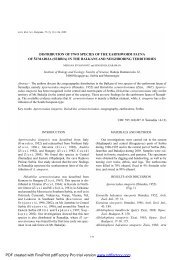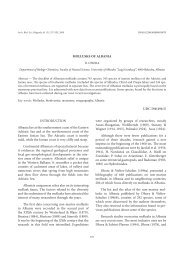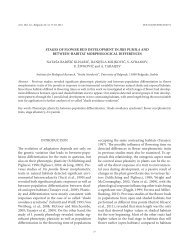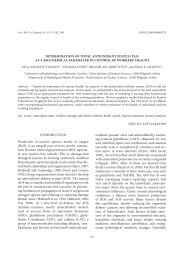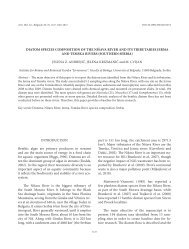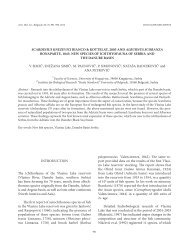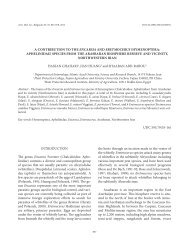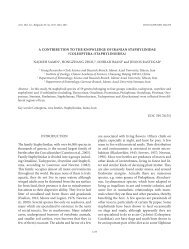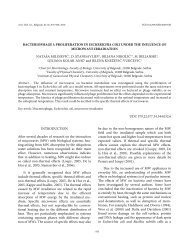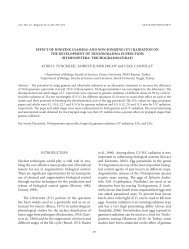Morphometric traits of the yellow honeybee (Apis mellifera carnica ...
Morphometric traits of the yellow honeybee (Apis mellifera carnica ...
Morphometric traits of the yellow honeybee (Apis mellifera carnica ...
You also want an ePaper? Increase the reach of your titles
YUMPU automatically turns print PDFs into web optimized ePapers that Google loves.
Arch. Biol. Sci., Belgrade, 63 (1), 251-257, 2011 DOI:10.2298/ABS1101251M<br />
MORPHOMETRIC TRAITS OF THE YELLOW HONEYBEE (<strong>Apis</strong> melliferA cArnicA)<br />
FROM VOJVODINA (NORTHERN SERBIA)<br />
M. MLADENOVIĆ 1 , RENATA RADOŠ 1 , L. Ž. STANISAVLjEVIĆ 2 , and S. RAŠIĆ 1<br />
1 University <strong>of</strong> Belgrade, Faculty <strong>of</strong> Agriculture, 11080 Belgrade, Serbia<br />
2 University <strong>of</strong> Belgrade, Faculty <strong>of</strong> Biology, 11000 Belgrade, Serbia<br />
Abstract: The morphometric <strong>traits</strong> <strong>of</strong> <strong>the</strong> <strong>yellow</strong> <strong>honeybee</strong> from Vojvodina were researched in this study. Samples were<br />
collected at seven locations: Banatsko Aranđelovo, Fruška Gora, Vladimirovci, Markovac and Vršac. Each sample contained<br />
50 bees whose body parts were prepared, scanned and measured using computer s<strong>of</strong>tware. The average values <strong>of</strong> <strong>the</strong><br />
measured parameters were: tongue length (6.12 mm), right-wing length (9.07 mm) and width (3.13 mm), number <strong>of</strong> wing<br />
hooks on <strong>the</strong> rear right-wing (21.44), cubital index (2,40), length (2.04 mm) and width (1.09 mm) <strong>of</strong> basitarsus<br />
<strong>of</strong> rear right leg, corbicula area (0.79 mm²), length (2.17 mm) and width (4.86 mm) <strong>of</strong> <strong>the</strong> third tergite, length<br />
(1.31 mm) and width (2.41 mm) <strong>of</strong> wax plate mirror. The obtained values <strong>of</strong> <strong>the</strong> observed parameters were consistent with<br />
<strong>the</strong> values that are characteristic to <strong>the</strong> Carniolan race <strong>of</strong> <strong>honeybee</strong>s (<strong>Apis</strong> <strong>mellifera</strong> <strong>carnica</strong> Poll).<br />
Key words: Honeybee, morphometric <strong>traits</strong>, variability<br />
INTRODUCTION<br />
<strong>Morphometric</strong> analyses <strong>of</strong> <strong>honeybee</strong>s are used to<br />
investigate <strong>the</strong> purity <strong>of</strong> <strong>the</strong> race. The <strong>honeybee</strong>,<br />
with its 42 studied morphological parameters, has<br />
become one <strong>of</strong> <strong>the</strong> most researched insects. Ruttner<br />
(1988) points out that by using precise morphometric<br />
studies, more ecotypes <strong>of</strong> <strong>the</strong> Carniolan<br />
<strong>honeybee</strong> races (<strong>Apis</strong> <strong>mellifera</strong> <strong>carnica</strong> Poll) may be<br />
identified. The first biometric research <strong>of</strong> honey bee<br />
populations in our region was that <strong>of</strong> Grozdanić<br />
(1926), where he identified <strong>the</strong> <strong>yellow</strong> form <strong>of</strong> Banat<br />
honey bee as a special group <strong>of</strong> bees called <strong>Apis</strong><br />
<strong>mellifera</strong> banatica. Research has been continued<br />
by Krunić (1967), Stojanović (1992), Plužnikova<br />
(1994), Georgiev (2000), Stevanović (2002), jeftić<br />
(2007), Mladenović and Simeonova (2008) and<br />
Nedić (2009).<br />
251<br />
UDC 638.12:595.799(497.113):575<br />
MATERIAL AND METHODS<br />
In this study, seven samples <strong>of</strong> <strong>yellow</strong> <strong>honeybee</strong> from<br />
different locations in Vojvodina (Fruška Gora (FG),<br />
Banatsko Aranđelovo (BA), Vladimirovci (U), Markovac<br />
(S and B), Vrsac (M, T)) were researched. Selected<br />
bee colonies were required to be in good condition,<br />
to have a satisfactory health status and to have<br />
a pure <strong>yellow</strong> queen bee and mostly <strong>yellow</strong> workers.<br />
Samples consisted <strong>of</strong> 50 bees that were drowned<br />
in pure alcohol and kept in <strong>the</strong> same alcohol until<br />
<strong>the</strong> measurement. The body parts <strong>of</strong> <strong>the</strong> bees were<br />
separated with tweezers, scanned in <strong>the</strong> resolution<br />
<strong>of</strong> 9600dpi and measured using <strong>the</strong> computer<br />
program AutoCAD. Temporary preparations were<br />
made. Measurements were done by standard method<br />
(Ruttner et al., 1978). Hooks on <strong>the</strong> rear wings were<br />
counted using a low magnification microscope.
252 M. MLADENOVIĆ ET AL.<br />
Table 1. Statistical parameters <strong>of</strong> <strong>the</strong> observed morphological <strong>traits</strong> <strong>of</strong> <strong>the</strong> examined samples <strong>of</strong> <strong>yellow</strong> honey bee from Vojvodina (average<br />
(x), minimum value (xmin), maximum value (xmax), variance (S2 RESULTS<br />
), standard deviation (S), standard error (SX), variation coefficient<br />
(V)).<br />
Trait Sample X Xmin Xmax S 2 S SX V<br />
Tongue length<br />
(mm)<br />
Wing length<br />
(mm)<br />
Wing width<br />
(mm)<br />
Cubital index<br />
Hook number<br />
T 5,66 4,74 6,46 0,41 0,64 0,09 11,31<br />
M 6,28 4,48 6,68 0,22 0,47 0,07 7,48<br />
S 6,23 4,89 6,65 0,17 0,41 0,06 6,58<br />
B 6,01 4,84 6,68 0,28 0,53 0,07 8,82<br />
FG 6,37 5,96 6,58 0,03 0,16 0,02 2,51<br />
U 6,18 5,47 6,51 0,04 0,21 0,03 3,40<br />
BA 6,10 4,81 6,59 0,20 0,45 0,06 7,38<br />
Average: 6,12<br />
T 8,98 8,41 9,37 0,04 0,21 0,03 2,34<br />
M 9,05 8,62 9,40 0,03 0,18 0,03 1,99<br />
S 9,30 8,91 9,64 0,03 0,17 0,02 1,83<br />
B 9,20 8,77 9,47 0,01 0,12 0,02 1,30<br />
FG 8,98 8,49 9,27 0,03 0,17 0,02 1,89<br />
U 8,94 8,46 9,33 0,03 0,18 0,03 2,01<br />
BA 9,01 8,45 9,54 0,05 0,23 0,03 2,55<br />
Average: 9,07<br />
T 3,16 3,05 3,31 0,00 0,06 0,01 1,89<br />
M 3,08 2,89 3,23 0,00 0,07 0,01 2,27<br />
S 3,24 3,09 3,41 0,00 0,07 0,01 2,16<br />
B 3,16 3,01 3,24 0,00 0,05 0,01 1,58<br />
FG 3,07 2,86 3,27 0,01 0,10 0,01 3,26<br />
U 3,10 2,21 3,32 0,03 0,16 0,02 5,16<br />
BA 3,11 2,90 3,29 0,01 0,09 0,01 2,89<br />
Average: 3.13<br />
T 2,50 1,61 3,21 0,13 0,36 0,05 14,40<br />
M 2,39 1,82 3,44 0,12 0,35 0,05 14,64<br />
S 2,49 1,73 3,33 0,12 0,34 0,05 13,65<br />
B 2,40 1,78 3,20 0,10 0,32 0,05 13,33<br />
FG 2,28 1,53 3,26 0,12 0,35 0,05 15,35<br />
U 2,30 1,52 3,52 0,13 0,36 0,05 15,65<br />
BA 2,44 1,72 3,39 0,08 0,28 0,04 11,47<br />
Average: 2,40<br />
T 21,72 19,00 24,00 1,44 1,20 0,17 5,52<br />
M 20,34 17,00 24,00 2,40 1,55 0,22 7,62<br />
S 22,96 19,00 27,00 3,17 1,78 0,25 7,75<br />
B 20,30 17,00 24,00 2,92 1,71 0,24 8,42<br />
FG 22,06 18,00 25,00 2,22 1,49 0,21 6,75<br />
U 21,50 17,00 26,00 2,96 1,72 0,24 8,00<br />
BA 21,20 18,00 24,00 1,80 1,34 0,19 6,32<br />
Average: 21,44
MORPHOMETRIC TRAITS OF THE YELLOW HONEYBEE FROM VOjVODINA 253<br />
Table 2. Statistical parameters <strong>of</strong> <strong>the</strong> observed morphological <strong>traits</strong> <strong>of</strong> <strong>the</strong> examined samples <strong>of</strong> <strong>yellow</strong> honey bee from Vojvodina (average<br />
(x), minimum value (xmin), maximum value (xmax), variance (S 2 ), standard deviation (S), standard error (SX), variation coefficient<br />
(V)).<br />
Trait Sample X Xmin Xmax S 2 S SX V<br />
Basitarsus length<br />
(mm)<br />
Basitarsus width<br />
(mm)<br />
Corbicula area<br />
(mm 2 )<br />
Third tergit length<br />
(mm)<br />
Third tergit width<br />
(mm)<br />
T 2,04 1,91 2,20 0,00 0,07 0,01 3,43<br />
M 1,97 1,72 2,15 0,01 0,09 0,01 4,57<br />
S 2,05 1,94 2,18 0,00 0,06 0,01 2,93<br />
B 2,03 1,91 2,15 0,00 0,06 0,01 2,96<br />
FG 2,07 1,92 2,20 0,00 0,07 0,01 3,38<br />
U 2,06 1,93 2,17 0,00 0,06 0,01 2,91<br />
BA 2,02 1,89 2,11 0,00 0,05 0,01 2,47<br />
Average: 2,04<br />
T 1,11 0,81 1,27 0,01 0,11 0,02 9,91<br />
M 1,03 0,73 1,22 0,01 0,12 0,02 11,65<br />
S 1,10 0,89 1,29 0,01 0,10 0,01 9,09<br />
B 1,04 0,81 1,26 0,02 0,13 0,02 12,05<br />
FG 1,11 0,95 1,22 0,00 0,07 0,01 6,31<br />
U 1,10 0,85 1,21 0,01 0,08 0,01 7,27<br />
BA 1,11 0,89 1,21 0,00 0,07 0,01 6,31<br />
Average: 1,09<br />
T 0,84 0,48 1,10 0,02 0,13 0,02 15,47<br />
M 0,80 0,54 1,16 0,02 0,13 0,02 16,25<br />
S 0,87 0,65 1,15 0,01 0,12 0,02 13,79<br />
B 0,82 0,60 1,28 0,02 0,14 0,02 17,07<br />
FG 0,77 0,44 0,97 0,01 0,12 0,02 15,58<br />
U 0,73 0,55 0,95 0,01 0,11 0,02 15,07<br />
BA 0,70 0,46 0,96 0,01 0,10 0,01 14,28<br />
Average: 0,79<br />
T 2,17 2,04 2,32 0,00 0,06 0,01 2,76<br />
M 2,18 2,03 2,36 0,00 0,07 0,01 3,21<br />
S 2,21 2,00 2,34 0,00 0,06 0,01 2,71<br />
B 2,23 2,12 2,34 0,00 0,05 0,01 2,24<br />
FG 2,14 1,97 2,31 0,01 0,08 0,01 3,74<br />
U 2,13 2,00 2,25 0,00 0,07 0,01 3,28<br />
BA 2,15 1,99 2,30 0,00 0,07 0,01 3,25<br />
Average: 2,17<br />
T 4,89 4,72 5,19 0,01 0,12 0,02 2,45<br />
M 4,78 4,39 5,46 0,03 0,16 0,02 3,47<br />
S 4,86 4,56 5,21 0,02 0,14 0,02 2,88<br />
B 4,95 4,60 5,14 0,01 0,11 0,01 2,22<br />
FG 4,90 4,56 5,22 0,02 0,15 0,02 3,06<br />
U 4,80 4,59 5,12 0,01 0,10 0,01 2,08<br />
BA 4,86 4,59 5,06 0,01 0,12 0,02 2,47<br />
Average: 4,86
254 M. MLADENOVIĆ ET AL.<br />
Table 3. Statistical parameters <strong>of</strong> <strong>the</strong> observed morphological <strong>traits</strong> <strong>of</strong> <strong>the</strong> examined samples <strong>of</strong> <strong>yellow</strong> honey bee from Vojvodina (average<br />
(x), minimum value (xmin), maximum value (xmax), variance (S 2 ), standard deviation (S), standard error (SX), variation coefficient<br />
(V)).<br />
Trait Sample X Xmin Xmax S 2 S SX V<br />
Wax plate mirror<br />
length (mm)<br />
Wax plate mirror<br />
width (mm)<br />
DISCUSSION<br />
Tongue length in <strong>the</strong> observed samples ranged from<br />
5.66 to 6.37 mm, with an average value <strong>of</strong> 6.12 mm.<br />
The obtained value is slightly lower compared to <strong>the</strong><br />
results obtained by o<strong>the</strong>r authors. jevtić (2007) stated<br />
that <strong>the</strong> tongue length in 18 experimental colonies<br />
from Serbia is 6.41 mm. Georgiev (2007) claimed<br />
that <strong>the</strong> tongue length <strong>of</strong> <strong>the</strong> bees from eastern Serbia<br />
is 6.34 to 6.50 mm. According to Mladenović and<br />
Simeonova (2008), <strong>the</strong> bees <strong>of</strong> sou<strong>the</strong>rn Serbia have<br />
an average tongue length <strong>of</strong> 6.58 mm. Kulincević et<br />
al. (1997) reported a length <strong>of</strong> 6.4 to 6.8 mm for <strong>the</strong><br />
bees from Banat. For <strong>the</strong> <strong>yellow</strong> bees from Vojvodina<br />
and Slavonia, Krunić (1967) reports 6.40 mm as <strong>the</strong><br />
length <strong>of</strong> <strong>the</strong> tongue. In studies <strong>of</strong> Plužnikov (1994),<br />
bees from Bosnia and Herzegovina had an average<br />
value <strong>of</strong> 6.44 mm for this parameter, and <strong>the</strong> bees<br />
from Serbia had a value <strong>of</strong> 6.39 mm.<br />
The data obtained by descriptive statistics (Table<br />
1) show that <strong>the</strong>re are variations from 8.94 to 9.30<br />
mm in <strong>the</strong> length <strong>of</strong> <strong>the</strong> wings <strong>of</strong> <strong>the</strong> observed sam-<br />
T 1,33 1,16 1,46 0,00 0,07 0,01 5,26<br />
M 1,32 1,17 1,44 0,00 0,05 0,01 3,78<br />
S 1,37 1,19 1,61 0,01 0,08 0,01 5,83<br />
B 1,33 1,25 1,42 0,00 0,05 0,01 3,75<br />
FG 1,28 1,13 1,40 0,00 0,05 0,01 3,90<br />
U 1,29 1,15 1,43 0,00 0,06 0,01 4,65<br />
BA 1,28 1,15 1,49 0,00 0,06 0,01 4,68<br />
Average: 1,31<br />
T 2,41 2,13 2,68 0,01 0,09 0,01 3,73<br />
M 2,42 2,13 2,67 0,01 0,08 0,01 3,30<br />
S 2,49 2,30 2,74 0,01 0,09 0,01 3,61<br />
B 2,49 2,26 2,71 0,00 0,07 0,01 2,81<br />
FG 2,33 2,11 2,48 0,01 0,09 0,01 3,86<br />
U 2,34 2,13 2,49 0,01 0,08 0,01 3,41<br />
BA 2,37 2,14 2,78 0,01 0,11 0,02 4,64<br />
Average: 2,41<br />
ples <strong>of</strong> <strong>yellow</strong> <strong>honeybee</strong> from <strong>the</strong> territory <strong>of</strong> Vojvodina.<br />
The obtained values for this trait are within <strong>the</strong><br />
range <strong>of</strong> values for <strong>the</strong> Carniolan race. According to<br />
Krivcov (1992) <strong>the</strong> wing length in <strong>the</strong> Carniolan race<br />
ranges from 9.00 to 9.40 mm. Stojanović (1992) in<br />
his research on <strong>the</strong> bees from Sjenica obtained values<br />
<strong>of</strong> 9.42 to 9.53 mm, in <strong>the</strong> bees from Lazarevac 9.79<br />
mm and in bees from Mariovo 9.32 to 9.55 mm. In<br />
<strong>the</strong> studies <strong>of</strong> Plužnikov (1994), <strong>the</strong> bees from Montenegro<br />
had an average value for this parameter <strong>of</strong><br />
9.73 mm, while <strong>the</strong> bees from Serbia had a value <strong>of</strong><br />
9.66 mm. jevtić (2007) obtained <strong>the</strong> value <strong>of</strong> 9.82<br />
mm for <strong>the</strong> wing length <strong>of</strong> bees from Banat. Georgiev<br />
(2007) indicates that <strong>the</strong>re is a variation from 9.28<br />
to 9.79 mm in <strong>the</strong> wing length <strong>of</strong> bees from eastern<br />
Serbia. Bees from sou<strong>the</strong>rn Serbia, according to research<br />
by Mladenović and Simeonova (2008), had a<br />
wing length <strong>of</strong> 8.96 mm. Somewhat different results<br />
were obtained by Stevanović (2002), where bees from<br />
30 localities throughout Serbia had a wing length <strong>of</strong><br />
6.50 mm. By analyzing <strong>the</strong> bees from Sudan, El Sarrag<br />
et al. (1992) state that an average value <strong>of</strong> wing<br />
length was 8.37 mm.
MORPHOMETRIC TRAITS OF THE YELLOW HONEYBEE FROM VOjVODINA 255<br />
Wing width in <strong>the</strong> observed samples ranged<br />
from 3.07 to 3.24 mm with an average value <strong>of</strong> 3.13<br />
mm. The data obtained for <strong>the</strong> wing width in <strong>yellow</strong><br />
<strong>honeybee</strong>s from Vojvodina have similar values that<br />
Krivcov (1992) states for <strong>the</strong> Carniolan honey bee,<br />
where <strong>the</strong> average value was 3.19 mm, with variation<br />
interval from 3.13 to 3.29 mm. In studies <strong>of</strong><br />
Plužnikov (1994) was indicated that <strong>honeybee</strong>s from<br />
Montenegro had an average value <strong>of</strong> 3.20 mm for<br />
this parameter, and <strong>the</strong> bees from Serbia had a value<br />
<strong>of</strong> 3.12 mm. In <strong>the</strong> studied colonies from Eastern<br />
Serbia, it was determined that <strong>the</strong> variation interval<br />
<strong>of</strong> <strong>the</strong> wing width was 3.16 to 3.52 mm (Georgiev,<br />
2006). Similar values for this parameter (3.23 mm)<br />
were obtained by jevtić (2007) in his study <strong>of</strong> Banat<br />
bees. Mladenović and Simeonova (2008) state that<br />
an average wing width <strong>of</strong> bees from sou<strong>the</strong>rn Serbia<br />
is 3.09 mm. Nedić (2009) reports values <strong>of</strong> 3.34<br />
mm in bees from Vranje and 3.23 mm in bees from<br />
Knjaževac.<br />
Variation intervals <strong>of</strong> <strong>the</strong> cubital index in <strong>yellow</strong><br />
honey bees from Vojvodina ranged from 2.28 to 2.50,<br />
with an average value <strong>of</strong> 2.40. The obtained value is<br />
within <strong>the</strong> values presented by o<strong>the</strong>r authors for <strong>the</strong><br />
Carniolan race. In <strong>the</strong> studies <strong>of</strong> Vlatković (1957),<br />
<strong>the</strong> value <strong>of</strong> cubital index for <strong>honeybee</strong>s from <strong>the</strong><br />
Peštersko-Sjenički plateau ranges from 2.3 to 3.6.<br />
Ruttner (1952) stated that <strong>the</strong> value <strong>of</strong> <strong>the</strong> cubital index<br />
is 2.74. Krunić (1967) obtained a cubital index<br />
value <strong>of</strong> 2.96 mm in <strong>the</strong> population <strong>of</strong> <strong>yellow</strong> bees<br />
from Vojvodina and Slavonia. In <strong>the</strong> studied colonies<br />
from eastern Serbia, it was shown that <strong>the</strong> variation<br />
interval for cubital index ranges from 2.45 to 2.65<br />
(Georgiev, 2006). Mladenovic et al. (2008) emphasize<br />
<strong>the</strong> value <strong>of</strong> 2.2 mm in bees from South Serbia.<br />
The average number <strong>of</strong> hooks on <strong>the</strong> rear wing<br />
in <strong>the</strong> observed sample was 21.44, while <strong>the</strong> variation<br />
interval ranges from 20.30 to 22.96. The resulting<br />
average value coincides with <strong>the</strong> average value<br />
<strong>of</strong> 21.21 presented by Krunić (1967) in research into<br />
<strong>the</strong> population <strong>of</strong> <strong>yellow</strong> bees from Vojvodina and<br />
Slavonia. The same author stated that <strong>the</strong> value for<br />
this parameter was 21.25 in <strong>the</strong> <strong>carnica</strong> population<br />
from mountainous areas. Alpatov (1927) indicates<br />
that <strong>the</strong> average number <strong>of</strong> hooks is 21.49 in bees<br />
from <strong>the</strong> territory <strong>of</strong> Bulgaria. Georgiev (2007) states<br />
that <strong>the</strong> variation interval in bees from eastern Serbia<br />
is 20.44 to 21.88.<br />
Basitarsus length ranged from 1.97 to 2.07 mm<br />
in <strong>the</strong> observed samples, <strong>the</strong> average value was 2.04<br />
mm. The results are consistent with <strong>the</strong> results <strong>of</strong><br />
Stojanović (1992), who analyzed honey bees from<br />
three regions and obtained values <strong>of</strong> 1.98 to 2.11 mm.<br />
Georgiev (2007) stated that <strong>the</strong> variation interval for<br />
this trait was from 2.03 to 2.34 mm in bees from eastern<br />
Serbia. In <strong>the</strong> research <strong>of</strong> Stevanović (2002) <strong>the</strong><br />
basitarsus length in bees from 30 localities in Serbia<br />
was 2.09 mm. jevtić (2007) indicates a length <strong>of</strong><br />
2.12 mm in bees from Banat, while Mladenović and<br />
Simeonova (2008) give an average value <strong>of</strong> 1.99 mm<br />
for <strong>the</strong> basitarsus length in bees from <strong>the</strong> south <strong>of</strong><br />
Serbia.<br />
Basitarsus width ranged from 1.03 to 1.11 mm in<br />
<strong>the</strong> observed samples, with an average value <strong>of</strong> 1.09<br />
mm. These results are similar to that <strong>of</strong> jevtić (2007)<br />
obtained by analyzing <strong>the</strong> bees from six localities in<br />
Serbia, where <strong>the</strong> greatest basitarsus width was determined<br />
in colonies <strong>of</strong> <strong>the</strong> Rasina and Banat ecotype<br />
(1.16 and 1.14 mm, respectively), and <strong>the</strong> smallest<br />
was in colonies <strong>of</strong> <strong>the</strong> Kopaonik ecotype (1.05 mm).<br />
Mladenović and Simeonova (2008) have determined<br />
a basitarsus width <strong>of</strong> 1.07 mm in bees from sou<strong>the</strong>rn<br />
Serbia. In <strong>the</strong> research <strong>of</strong> Georgiev (2007) it was<br />
found that <strong>the</strong> variation interval for this trait ranged<br />
from 1.04 to 1.37 mm in <strong>honeybee</strong>s from eastern<br />
Serbia. A similar average value (1.13 mm) was determined<br />
by Stevanović (2002).<br />
The corbicula area ranged from 0.70 to 0.87 mm 2<br />
in <strong>the</strong> seven samples from <strong>the</strong> Vojvodina region,<br />
with an average value <strong>of</strong> 0.79 mm 2 . By measuring 387<br />
samples, Milne et al. (1986) found that <strong>the</strong> tibia area<br />
is 1.54 to 2.28 mm 2 . Poklukar (1999) stated that <strong>the</strong><br />
average tibia area in bees from Slovenia is 2.65 mm 2 .<br />
The length <strong>of</strong> <strong>the</strong> third tergite ranged from 2.13<br />
to 2.23 mm in <strong>the</strong> observed samples, with an average<br />
value <strong>of</strong> 2.17 mm. The obtained data are similar to
256 M. MLADENOVIĆ ET AL.<br />
data provided by Plužnikov (1994) for this parameter,<br />
obtained by examining <strong>the</strong> bees from Bosnia<br />
and Herzegovina (2.17 mm), Montenegro (2.2 mm)<br />
and Serbia (2.32 mm). Georgiev (2007) give a variation<br />
interval from 1.91 to 2.18 mm for this trait in<br />
bees from eastern Serbia. Simeonova (2009), for bees<br />
from <strong>the</strong> north <strong>of</strong> Kosovo and Metohija (Kosmet),<br />
states an average <strong>of</strong> 2.75 mm and Mladenović and<br />
Simeonova (2009) determined a value <strong>of</strong> 2.62 mm<br />
for <strong>the</strong> length <strong>of</strong> <strong>the</strong> third tergite by examining honey<br />
bees from central Kosmet.<br />
The width <strong>of</strong> <strong>the</strong> third tergite ranged from 4.78 to<br />
4.95 mm, and <strong>the</strong> average value was 4.86 mm. The obtained<br />
data are similar to data provided by Plužnikov<br />
(1994) obtained by examining <strong>the</strong> bees from Bosnia<br />
and Herzegovina (4.73 mm), Montenegro (4.70<br />
mm) and Serbia (4.73 mm). Georgiev (2007) stated<br />
that <strong>the</strong> variation interval for this trait is from 4.00<br />
to 4.87mm in bees from eastern Serbia. Simeonova<br />
(2009) stated that for bees from <strong>the</strong> north <strong>of</strong> Kosmet,<br />
<strong>the</strong> average value is 5.88 mm and Mladenović and<br />
Simeonova (2009a), in <strong>the</strong>ir studies <strong>of</strong> <strong>honeybee</strong>s<br />
from central Kosmet, obtained a value <strong>of</strong> 5.68 mm<br />
for this trait.<br />
The wax plate mirror length in <strong>the</strong> observed samples<br />
ranged from 1.28 to 1.37 mm, with an average<br />
value <strong>of</strong> 1.31 mm. The results obtained in <strong>the</strong> seven<br />
examined samples are slightly lower compared to <strong>the</strong><br />
results that Plužnikov (1994) presented when examining<br />
<strong>the</strong> bees from Serbia (1.44 mm) and Montenegro<br />
(1.53 mm). Georgiev (2007) indicates that <strong>the</strong><br />
variation interval is 1.25 to 1.47 mm for this trait in<br />
bees from eastern Serbia. Simeonova (2009) determined<br />
an average value <strong>of</strong> 1.89 mm in bees from <strong>the</strong><br />
north <strong>of</strong> Kosmet, and Mladenović and Simeonova<br />
(2009a), in examining <strong>the</strong> <strong>honeybee</strong>s from central<br />
Kosmet, obtained <strong>the</strong> value <strong>of</strong> 1.94 mm for <strong>the</strong> length<br />
<strong>of</strong> wax plate mirrors.<br />
The width <strong>of</strong> <strong>the</strong> wax plate mirror in <strong>the</strong> observed<br />
samples ranged from 2.33 to 2.49 mm, with<br />
an average value <strong>of</strong> 2.41 mm. The results are in<br />
concurrence with <strong>the</strong> results <strong>of</strong> Plužnikov (1994)<br />
where <strong>the</strong> width <strong>of</strong> <strong>the</strong> wax plate mirrors in bees<br />
from Serbia is 2.45 mm, from Montenegro it is 2.42<br />
mm and from Bosnia and Herzegovina 2.49 mm.<br />
Georgiev (2007) indicates a variation interval from<br />
2.06 to 2.15 mm for this trait in bees from eastern<br />
Serbia. Simeonova (2009), for bees from nor<strong>the</strong>rn<br />
Kosmet, determined an average value <strong>of</strong> 3.03 mm,<br />
and Mladenović and Simeonova (2009a), in examining<br />
<strong>the</strong> honey bees from central Kosmet, obtained<br />
<strong>the</strong> value <strong>of</strong> 3.16 mm for <strong>the</strong> width <strong>of</strong> <strong>the</strong> wax plate<br />
mirrors.<br />
A detailed taxonomic analysis (from <strong>the</strong> morphological<br />
to molecular level) needs to be carried<br />
out on <strong>honeybee</strong>s from <strong>the</strong> whole Pannonian Plain.<br />
Honeybees from Vojvodina and Serbia represent an<br />
indigenous gene pool within A. m. <strong>carnica</strong>, with a<br />
small number <strong>of</strong> specific populations created during<br />
evolution. Because <strong>the</strong> territory <strong>of</strong> <strong>the</strong> Balkan Peninsula<br />
was a refugium for many animal species during<br />
<strong>the</strong> period <strong>of</strong> <strong>the</strong> Ice Age in <strong>the</strong> Pleistocene (Schmitt,<br />
2007), <strong>the</strong> <strong>honeybee</strong> haplotypes <strong>of</strong> Serbia (Nedić et<br />
al., 2009) could be regarded as relict groups. For a<br />
distinct separation <strong>of</strong> <strong>the</strong> areas <strong>of</strong> dissemination <strong>of</strong><br />
certain <strong>honeybee</strong> subspecies and ecotypes, it is necessary<br />
to take into account both morphological characteristics<br />
and molecular markers.<br />
Acknowledgments - The study was supported by <strong>the</strong> Serbian<br />
Ministry <strong>of</strong> Science and Technological Development (Grants:<br />
20102 and 143006)<br />
REFERENCES<br />
Alpatov V.V. (1927). On <strong>the</strong> variability <strong>of</strong> <strong>the</strong> hamuli on <strong>the</strong> hind<br />
wings <strong>of</strong> <strong>the</strong> <strong>honeybee</strong>. Ptschelowodnoje Djelo. 1–7. (In<br />
Russian).<br />
El Sarrag M.S.A., Saeed A.A., and M.A. Hussein (1992). <strong>Morphometric</strong>al<br />
Study on <strong>the</strong> Sudanese Honeybees. J. King Saud<br />
Univ. v4. Agric. Sci. (I), 99–108.<br />
Georgijev A. (2000). Biometrijske karakteristike medonosne<br />
pčele (<strong>Apis</strong> <strong>mellifera</strong> <strong>carnica</strong> Pollmann) Timočkog regiona.<br />
Specijalistički rad. Poljoprivredni fakultet, Univerzitet u<br />
Beogradu, str. 1–120.<br />
Georgijev A. (2007). Biološko produktivne osobine medonosne<br />
pčele u Istočnoj Srbiji, Magistarska teza, Beograd.<br />
Grozdanić S. (1926). „Žuta“ banatska pčela. Glasnik entomološkog<br />
društva, 1, 1–16.
MORPHOMETRIC TRAITS OF THE YELLOW HONEYBEE FROM VOjVODINA 257<br />
Jevtić G. (2007). Varijabilnost ekotipova medonosne pčele (<strong>Apis</strong><br />
<strong>mellifera</strong> <strong>carnica</strong> Poll.) i njihov značaj u oprašivanju lucerke.<br />
Doktorska disertacija, Univerzitet u Beogradu, Poljoprivredni<br />
fakultet, 1–139.<br />
Krivcov N. I. (1992). Kranjska rasa pčela. Preveo i priredio R.<br />
Živadinović, Pčelar, Beograd, jun 2004, str. 261.<br />
Krunić M. (1967). Varijabilitet <strong>Apis</strong> meliffica L. u jugoslaviji sa<br />
posebnim osvrtom na diferencijaciju populacija u Panonskoj<br />
niziji. Doktorska disertacija, Beograd.<br />
Kulinčević J., Krunić M., and Lj. Stanisavljević (1997). Medonosne<br />
i druge vrste domestifikovanih pčela kao genetički,<br />
ekološki i privredni resursi jugoslavije. Savremena poljoprivreda,<br />
46 (1–2), 257–268.<br />
Mladenović M., and V. Simeonova (2008). Morfometrijske karakteristike<br />
medonosne pčele reprostanica na jugu Srbije.<br />
XVI Naučno savetovanje sa međunarodnim učešćem, Zemun,<br />
1–7.<br />
Mladenović M., and V. Simeonova (2009). Morfometrijske osobine<br />
domaće karnike sa područja severnog Kosmeta. XVII<br />
naučno savetovanje sa međunarodnim učešćem, Zemun,<br />
80–87.<br />
Mladenović M., and V. Simeonova (2009a). Morfometrijske karakteristike<br />
medonosne pčele autohtone rase sa područja<br />
centralnog Kosmeta. Zbornik sažetaka, XIV Međunarodno<br />
naučno-stručno savjetovanje agronoma Republike<br />
Srpske, „Poljoprivreda ruralnog područja kao faktor integracije<br />
u EU“, Poljoprivredni fakultet, Banja Luka, Trebinje,<br />
23–26. mart, str. 225.<br />
Milne C. P. Jr., Hellmich R. L., and K. J. Pries (1986). Corbicular<br />
size in workers from <strong>honeybee</strong> lines selected for high or<br />
low pollen hoarding. Journal <strong>of</strong> Apicultural Research 25,<br />
50–52.<br />
Nedić N. (2009). Biološko–proizvodne osobine medonosne pčele<br />
<strong>Apis</strong> <strong>mellifera</strong> <strong>carnica</strong> Poll. na teritoriji Srbije. Doktorska<br />
disertacija, Beograd.<br />
Nedić N., Stanisavljević Lj., Mladenović M., and J. Stanisavljević<br />
(2009). Molecular characterization <strong>of</strong> <strong>the</strong> <strong>honeybee</strong> <strong>Apis</strong><br />
<strong>mellifera</strong> <strong>carnica</strong> in Serbia. Archives <strong>of</strong> Biological Sciences,<br />
61(4), 587-598.<br />
Plužnikov L. (Плужников Л.) (1994). Характеристика морфологичесkих<br />
и хозяйственньix признаков пчел Югославии.<br />
Дисертации, Государственньiй Аграрньiй Университет<br />
Кишинев, Республика Молдова.<br />
Poklukar J. (1999). Kranjska čebela je osvojila Češko (Carniolan<br />
bee has conquerred Bohemia). Slovenski Čebelar 101,<br />
277–278.<br />
Ruttner F. (1952). Alter und Herkunft der Bienenrassen Europas,<br />
Österr. Imker (2), 8–10.<br />
Ruttner F., Tassencourt L., and J. Louveaux (1978). Biometrical<br />
statistical analysis <strong>of</strong> <strong>the</strong> geographic variability <strong>of</strong> <strong>Apis</strong><br />
<strong>mellifera</strong> L., Apidologie, 9, 363–381.<br />
Ruttner F. (1988). Biogeography and taxonomy <strong>of</strong> <strong>honeybee</strong>s.<br />
Springer–Verlag, Berlin, Heidelberg, 1–284.<br />
Stevanović J. (2002). Istraživanja morfometrijske i hromozomske<br />
varijabilnosti u funkciji očuvanja diverziteta kranjske<br />
medonosne pčele (<strong>Apis</strong> <strong>mellifera</strong> <strong>carnica</strong> Pollmann, 1879)<br />
na teritoriji Srbije. Magistarska teza, Biološki fakultet, Beograd,<br />
1–190.<br />
Schmitt, T. (2007). Molecular biogeography <strong>of</strong> Europe: Pleistocene<br />
cycles and postglacial trends. Frontiers Zool. 4, 11-<br />
23.<br />
Stojanović R. (1992). Izučavanje biometrijskih karakteristika<br />
elemenata spoljašnje morfologije medonosne pčele (<strong>Apis</strong><br />
mellifica L.) sa različitih geografskih područja naše zemlje.<br />
Magistarska teza, Veterinarski fakultet, Beograd,<br />
1–100.<br />
Vlatković B. (1957). Pčele sjeničke kotline i visoravni Peštera i<br />
uslovi pčelarenja. Acta Veterinaria 7(2): 3–18.



